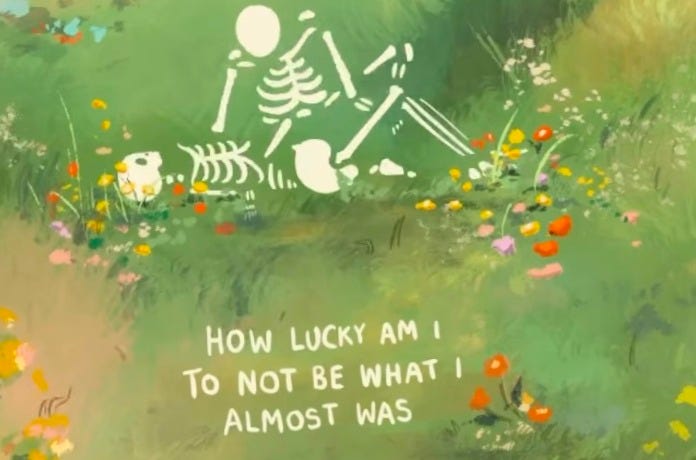Enter Label: The Good & Bad of the Mind-Body Dogma
Studies on the Biology of Belief: Placebo, TMS, Mind-Body, Amor Fati, Jung
Dear Companions,
When I meet a wayward journeyer in the Healingvrse, sometimes the exchange slips into dictation, like My Fair Lady.
I’ll get crucified for calling recovery or meditation hard. Suddenly, they’re stumbling over themselves to stop another “negative” word from leaving my mouth. Why can’t it be hard?
This is the telltale sign of a zealot of the Biology of Belief (BOB)—the idea that the mind controls healing. For true believers, the way you articulate your thoughts indicates your capacity for recovery. Should you express negativity or stray from doctrine, your chances of improvement diminish. You become a lost cause, no different from the fate prescribed by conventional medicine.
I get it. I’ve read the literature. I’ve seen belief save lives—mine included. The Biology of Belief has made me keenly aware that complaining is pretty much always a waste of time—yours and mine. Still, it’s definitely a spectrum. And people who get to the other side should remember that when talking to people still working hard.
Defining the “Biology of Belief”
The BOB perspective often begins with research into the placebo effect. Is that what is at work when people post how a dose of .05mg low dose naltrexone helped eliminate muscle and joint pain? To put in perspective the full low dose is around 4.5mg, and still more, the full proper dosage is 50mg.
Henry K. Beecher’s “The Powerful Placebo” (1955) highlighted the role of expectation in healing, finding up to 35% of individuals experienced relief from placebos.
Ted Kaptchuk et al. (2010) demonstrated that even when patients know they’re taking an inert pill, they can still feel better. Open-Label Placebos revealed that engaging in a treatment routine—receiving a pill from a trusted clinician—can foster hope and measurable physiological changes.
For those for whom placebo effect is not sufficient, there is a new risk. Not only do symptoms remain but repeated doctor visits, misdiagnoses, and conflicting treatments reinforce a sense of illness identity.
Genuine grief and fear take root. This isn’t a hole—this is the abyss. Now, you are struggling to avoid labeling yourself as “chronically ill.” After a few months of this conventional path, you will have to wonder: what else is there?
GOING DEEPER: TMS, Somatic Therapy
So, with no magic pill—you venture further. Those with pain or unexplained illness, often explore TMS (Tension Myositis Syndrome), pioneered by Dr. John Sarno. He treated patients with the idea that chronic pain or symptoms result not from structural damage but from learned neural networks—fear or “danger” signals stored in our emotional centers. This is where I discovered BOB after 6 months of the vaccine injury and relentless head pain.
I’ve compiled a list of key resources that shaped my conversion. But what really secured my belief were the studies. Whether they were small samples or based on shaky functional MRI science made no difference. People who worry about that ad nauseum have the luxury of health, inexperience, or callousness. Or who knows, maybe they found success with the placebos.
Baliki et al. (2008) showed that acute pain activates the somatosensory cortex, while chronic pain engages the medial prefrontal cortex—an area tied to emotions. Therefore, chronic pain and symptoms can become learned, like a language.
Ashar et al. (2021) showed mind-body interventions can significantly reduce activation in pain-related regions, highlighting how shifts in emotional and cognitive perceptions disrupt chronic pain cycles.
Some experience miraculous healing with this kind of information—years of pain gone in a day. More commonly, people find healing within months or years of learning these concepts. They will do pain reprocessing therapy similar to CBT. The most important aspect of the BOB is to believe that there is nothing wrong with your body, despite its sensations. This is one of the hardest beliefs I’ve had to acquire in my life.
Zealots
At first you feel the warmth of acceptance. Your people. Across thousands of mysterious ailments are people who are engaging in the BOB.
But there are dark corners. Discussing conventional medicine, physical therapy, or targeted diets can get you thrown out of groups. Some advocates take it to extremes: no massage for back pain, no Tylenol, no “crutches” that undermine mental conviction. They believe attributing relief to external aids dilutes one’s belief in self-healing. They will make you feel bad about taking a nerve medication, or a low dose anti-depressant or heaven forbid—an anti-anxiety medication.
Mind-Body Approach
This can bring you toward the mind-body approach that transcends self-talk safety messages or exposure therapy, delving into deeper somatic work, recognizing the bidirectional flow of signals between the mind and body. The surface area of recovery now grows.
Porges SW (2007) – “The Polyvagal Perspective,” which shows that vagus nerve (ventral vs. dorsal) mediate responses from calm social engagement to defensive shutdown, linking physiological states with emotional well-being.
Farb et al. (2013) found that mindfulness meditation training alters brain processing of internal bodily sensations (interoception), reinforcing the interplay between emotional regulation and body-awareness.
However, even in these spaces, there are some missing elements understood by the Ancient Greeks. The mind and body may remain unmoored. Some need more as frustration and helplessness mounts. If healing happens before this point, major changes may not be adopted.
DESTINATION UNKNOWN: JUNG AND AMOR FATI
At this point, our weary traveler has tried a lot of things and is at least a year or two into their ailment. Soon they encounter amor fati, a concept recently featured in the finale of The White Lotus but originally articulated by Nietzsche.
It is the profound and exculpatory belief of embracing all aspects of one’s life—even the painful or tragic events—rather than merely accepting or resigning oneself to them. By loving one’s fate, a person gains deeper meaning from hardship, avoids dwelling on regrets, and cultivates resilience.
This resonates with recent research on posttraumatic growth (PTG). Those who endure events like war or catastrophic injury often discover profound meaning in their journeys, contrary to the view of destruction of PTSD.
Tedeschi & Calhoun (1996, 2004) introduced PTG, asserting that surviving severe crises can lead to greater appreciation for life, deeper personal strength, and a worldview shift.
Prati & Pietrantoni (2009) – Meta-Analysis found a strong link between positive reinterpretation—essentially, the meaningful reframing of suffering—and elevated scores in post-traumatic growth (PTG).
To unravel deeper meanings, the most downtrodden among us explore Jungian frameworks where the shadow world is investigated. It values dreamwork and active imagination, mirroring ancient Greek healing traditions. Here, the BOB embraces synchronicity, signs from the universe, unconscious messages, and the connection between all living things.
We break away from the rigid categorizations of Freudian neurosis and illness, reaching into the mystical explanations of psychology, like Jung did when he diverged from Freud to embrace alchemical concepts. This rich history is beautifully explored in this post by
.A BROADER VIEW ON HEALING
I wonder why people don’t explore all of mind, body, and soul in unison. Bryan Johnson for instance skews heavily to the body and often talks as though he rejects the mind. This is why I’m certain there’s a market for the Healingvrse.
It’s crucial to remember that belief can be complex: a person might doubt their ability to control a symptom yet firmly believe in their power to overcome suffering overall. Everyone’s route is distinct, shaped by the unique elements of their condition, support system, and so on. Sometimes belief is just a function of timing—that you’ve had enough time in between setbacks to explore and implement a belief. In this sense, belief is also a product of luck.
THE BEST ADVICE
Anyway, the last thing someone who is pouring out their heart to you—whether online or in person—needs is a pedantic lesson about which words are acceptable. It’s easy to feel passionate when something WORKS, but language alone doesn’t expose their mentality, nor does it determine whether they’ll recover. People can parrot the perfect vernacular and dog whistle in the Healingvrse but I find perfect healing tropes highly suspect.
What does help?
Share Your Experience. Offer what specifically worked for you. Rather than scolding someone for saying “meditating is hard,” suggest the tiny first steps you took to make it feel approachable.
Recommend Resources. A book, a well-researched program, or an affirmation app like Think UP can empower others to tailor their journey. Maybe “hard” isn’t the main barrier for them—maybe it’s viewing themselves as a victim. Can’t go wrong with suggesting Neff, Pema, Thich, Alan Gordon, or distractions like My Beautiful Friend, and all the ones at Away Messages.
Recognize Individual Paths. One person’s Biology of Belief might be bolstered by working with a functional doctor or using an antidepressant to get over the hump—until they’re ready to adopt a deeper belief system. Some individuals just need more time or more interaction with what you might call the placebo effect to build that inner resilience.
Ask for Meaning. If all else fails, inquire into the meaning they may have found. They may be tongue tied for the answer, but it’s better than offering bad advice.
I would love to hear what the BEST piece of advice (or most annoying) you have ever received from someone.
Other RESOURCES
-More TMS resources with a new app for getting back to movement after long periods of exercise intolerance
-Latest Research on Post Traumatic Growth
With much love from the (hard) Healingvrse,
Rebecca






The more I progress through my healing journey, the more obvious it gets that my physical symptoms are tied to anger, fear and shame. I used to think the symptoms were 'physicalisations' of my emotions, sort of like somatic metaphors, but the writing of Max Goodbird (Superb Owl) has helped me understand that emotions are physical things in the first place. They're always your body doing something, and when it gets stuck doing the same thing on a loop you have 'chronic' problems.
Weekly Gestalt therapy is currently my best tool for addressing my shame, although 'hard' is damn right - the only way to let the trapped feelings out of my body is to actually feel them, and that can be torture. What's encouraging though is that even if I'm not exactly *happier* day to day (things have to get worse before they get better), I feel somehow lighter, more capable and more resilient. I notice myself acting more confidently and looking forward to used-to-be-difficult things more (or at least dreading them less).
So even if my head is full of past wounds that need healing, I feel better equipped to handle what's happening *now* than I used to, and that's setting me up to have a future that's more joyful than my past. Does any of that sound familiar to you too? :)